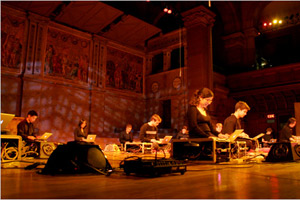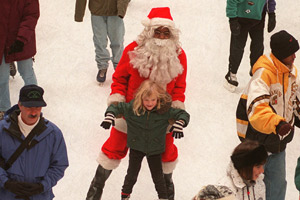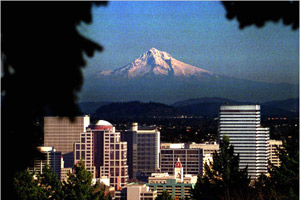Focus on America
Laptop Orchestra Turns Electronic Sounds into Music

One way people often use laptop computers is to download and play music files. Recently, some musicians have gone a step further, harnessing the ability of laptops to generate all kinds of sounds electronically to use the machines themselves as musical instruments.
Using laptops this way is not that different from the way hip-hop artists of the 1970s used turntables to “scratch” old, worn records to talk over music, creating an entirely new musical genre, composer and sound artist Scott Smallwood tells USINFO.
Smallwood is a co-director of PLOrk, the Princeton Laptop Orchestra, at Princeton University in New Jersey. The orchestra was founded in 2005 by faculty members Dan Trueman and Perry Cook with graduate students Smallwood and Ge Wang, and is a collection of musicians who perform together using computers as their instruments. The computer-generated music is based on new kinds of sounds -- made up of noise and texture -- rather than the traditional sounds of instruments in an orchestra.
Performances by the Princeton Laptop Orchestra differ from those by most laptop musicians because the orchestra members are working together from a musical score, or instructions to the whole group that govern what sounds are made by which musicians at what time, rather than individual musicians performing works with "their own voice."
That the notion of a “laptop orchestra” seems contradictory is a prime motivation for creating one, Trueman wrote in a published paper.
For such musicians and innovators, the paradox is the source of much of the fun.
When people hear the term “laptop orchestra” they think of a symphony orchestra and assume it is a group of people sitting around with computers mimicking such instruments as the violin or clarinet, according to Smallwood.
“It is not about this,” he said. Instead, the laptop symphony makes new and unique sounds work in the same acoustical context as a traditional symphony.
SPECIAL SPEAKERS ENABLE LAPTOP MUSICIANS TO PLAY ACOUSTICALLY
Computers have had the ability to replicate individual instruments in a band or orchestra for years -- in fact, many pit orchestras in live-performance theaters have been replaced by a single computer that is programmed to play an entire musical score. What distinguishes the laptop orchestra from electronic music is the role each musician plays in the group and the unique speakers designed by Trueman and connected to each laptop to enable electronic sound to become acoustic.
The idea for using speakers with electronic music originally was intended to project sound in a single direction, Smallwood said, but the resonances became blurred, which posed a challenge to electronic musicians. “Youve got speakers mounted above the stage blasting sound out into space,” he said. “Sometimes that is a good thing, but sometimes you want to play like an acoustic musician maintaining the locality of sound.”
When jazz musicians are improvising, they are playing off each other and part of the information they are using is where the sound is coming from, Smallwood explained.
The idea for the special speaker design was to make the computer work like an acoustic instrument, where the sound comes from the individual laptop rather than a loudspeaker, he said. The PLOrk speakers, the large SenSA (Bubba) and the original Bowed-Sensor-Speaker-Array (BoSSA), radiate sound in all directions.
Trueman has disseminated information widely on how to make the speakers, according to Smallwood, and there are companies that will custom-make them. This step is expensive for an entire laptop orchestra, though, because each person requires an individual sound source.
SMALLWOODS INTEREST IN MUSIC STARTED AT YOUNG AGE
Smallwood’s interest in music began at an early age when he learned to play the piano and several other instruments in his school band. At the age of 10, his father gave him a tape recorder. Smallwood was captivated by the device and used it to record sounds. Soon, he made recordings of sound effects and used them to accompany his puppet shows in the family’s living room.
Smallwood eventually became interested in electronic music. Currently, he is completing his doctoral dissertation in the music department at Princeton University, where he is working on sonic photography, or making sonic snapshots of places.
Recently on Focus on America
New York City gets ready for its annual New Year Celebration
 For much of the past century, Americans have associated the new year with festivities in New York City’s Times Square -- in the center of the nation’s largest, most diverse and perhaps most forward-looking city.
For much of the past century, Americans have associated the new year with festivities in New York City’s Times Square -- in the center of the nation’s largest, most diverse and perhaps most forward-looking city.
Christmas, celebrated by most Christians on December 25.
 Christmas, celebrated by most Christians on December 25, commemorates the birth of Jesus of Nazareth. Americans, like many of the world’s peoples, have developed their own Christmas traditions and observances, and these have changed greatly over time.
Christmas, celebrated by most Christians on December 25, commemorates the birth of Jesus of Nazareth. Americans, like many of the world’s peoples, have developed their own Christmas traditions and observances, and these have changed greatly over time.
Wealth and Hard Times Mingle in Northwest Oregon
 The Oregon 1st Congressional District stretches from a vibrant metropolitan area, across densely packed suburbs and rolling farm country through the mists of forested hills before ending on one of the world’s most spectacular coastlines.
The Oregon 1st Congressional District stretches from a vibrant metropolitan area, across densely packed suburbs and rolling farm country through the mists of forested hills before ending on one of the world’s most spectacular coastlines.